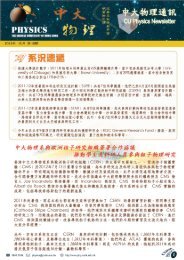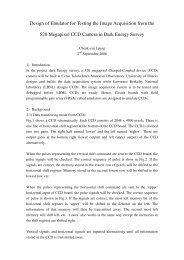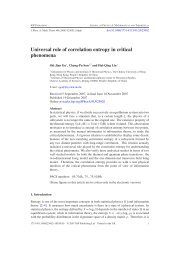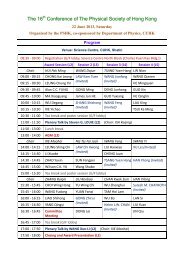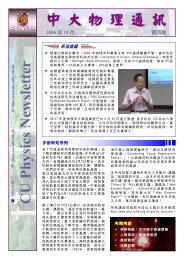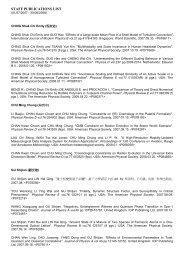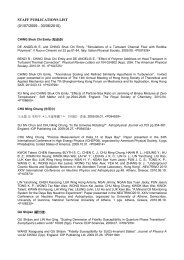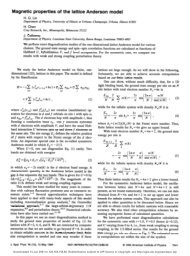Phonon-mediated superconducting transitions in layered cuprate ...
Phonon-mediated superconducting transitions in layered cuprate ...
Phonon-mediated superconducting transitions in layered cuprate ...
You also want an ePaper? Increase the reach of your titles
YUMPU automatically turns print PDFs into web optimized ePapers that Google loves.
CHEN et al.<br />
homologous series. 38,39 The dramatic enhancement of T c was<br />
usually generated by external pressure <strong>in</strong> <strong>layered</strong> <strong>cuprate</strong>s,<br />
specifically <strong>in</strong> mercury-based family. 40–44 The cation disorder<br />
was found to suppress T c <strong>in</strong> many <strong>cuprate</strong>s. 45–48 The<br />
comprehensive understand<strong>in</strong>g of these <strong>superconduct<strong>in</strong>g</strong> transition<br />
properties with<strong>in</strong> one s<strong>in</strong>gle theoretical framework is<br />
still challeng<strong>in</strong>g. Another crucial question is whether these<br />
<strong>in</strong>terest<strong>in</strong>g effects can be understood based on a phonon<strong>mediated</strong><br />
theory.<br />
In this work we address these issues by study<strong>in</strong>g rather<br />
rich <strong>superconduct<strong>in</strong>g</strong> transition features <strong>in</strong> a model homologous<br />
series of HgBa 2 Ca n−1 Cu n O 2n+2+ . We develop a<br />
phonon-<strong>mediated</strong> d-wave BCS-like model for <strong>layered</strong> superconductors.<br />
The systematic <strong>in</strong>vestigations of mercury-based<br />
<strong>superconduct<strong>in</strong>g</strong> series enable us to clarify some properties<br />
shared by different <strong>cuprate</strong>s. We show that the theoretical<br />
model is successful <strong>in</strong> expla<strong>in</strong><strong>in</strong>g the dependence of both the<br />
<strong>superconduct<strong>in</strong>g</strong> transition temperature T c and oxygen isotope<br />
exponent on the dop<strong>in</strong>g level, number of CuO 2 layers,<br />
pressure, and lattice distortion <strong>in</strong> <strong>cuprate</strong> superconductors.<br />
The <strong>in</strong>terlayer coupl<strong>in</strong>g is found to play an important role <strong>in</strong><br />
the significant enhancement of T c and <strong>in</strong> the systematic reduction<br />
of <strong>in</strong> a <strong>layered</strong> homologous series.<br />
The outl<strong>in</strong>e of this paper is as follows: In Sec. II, we give<br />
the phonon-<strong>mediated</strong> d-wave BCS equation <strong>in</strong> the general<br />
case of any CuO 2 layers per unit cell. We choose<br />
HgBa 2 Ca n−1 Cu n O 2n+2+ as an example to study the possibility<br />
of phonon-<strong>mediated</strong> superconductivity. Section III is devoted<br />
to the numerical results and analysis for the <strong>superconduct<strong>in</strong>g</strong><br />
transition temperature as functions of the hole<br />
concentration and number of CuO 2 layers at atmosphere<br />
pressure. In Sec. IV, we give the general formalism for the<br />
oxygen isotope exponent. We predict the oxygen isotope effects<br />
and discuss the role of <strong>in</strong>terlayer coupl<strong>in</strong>g on them.<br />
Section V is focused on the pressure dependence of both the<br />
<strong>superconduct<strong>in</strong>g</strong> transition temperature and isotope exponent.<br />
Three variables are proposed to account for the pressure<br />
effects. We use the framework to analyze presently<br />
available data, compare our results to experiments, and suggest<br />
further measurements. In Sec. VI, we show how the<br />
phonon frequency changes the <strong>superconduct<strong>in</strong>g</strong> transition<br />
temperature and isotope effect. The physical implication of<br />
this behavior to the observed lattice distortion is also discussed.<br />
In Sec. VII, we exam<strong>in</strong>e the validity of the theoretical<br />
model <strong>in</strong> other homologous series such as the Bi- and<br />
Tl-based family. Conclusions are presented <strong>in</strong> Sec. VIII.<br />
II. THEORETICAL APPROACH<br />
Let us start with the model Hamiltonian <strong>in</strong>clud<strong>in</strong>g the<br />
basic <strong>in</strong>-plane pair<strong>in</strong>g term and a weak <strong>in</strong>terlayer tunnel<strong>in</strong>g<br />
coupl<strong>in</strong>g term:<br />
H = k − c k<br />
lk<br />
+ <br />
ll<br />
†l l<br />
c k<br />
V kc k↑<br />
k<br />
+ V kk c k↑<br />
lkk<br />
†l †l<br />
c −k↓ c<br />
l<br />
−k↓ck↑<br />
†l †l l l<br />
c −k↓ c −k ↓<br />
l ,<br />
c k ↑<br />
†l<br />
where c k is a quasiparticle creation operator on layer l with<br />
1<br />
sp<strong>in</strong> projection and wave-vector k, k is the quasiparticle<br />
dispersion, is the chemical potential, the summation over<br />
ll runs over the layer <strong>in</strong>dices of the unit cell, and the pair<strong>in</strong>g<br />
potential V kk is assumed to be <strong>in</strong>dependent of l, orig<strong>in</strong>at<strong>in</strong>g<br />
from some of the proposed mechanisms, which we do not<br />
attempt at specify<strong>in</strong>g. The <strong>in</strong>terlayer tunnel<strong>in</strong>g is parameterized<br />
by V k=V g 4 k, with gk=cos k x −cos k y and V <br />
be<strong>in</strong>g the <strong>in</strong>terlayer tunnel<strong>in</strong>g strength. 49<br />
By characteriz<strong>in</strong>g the <strong>superconduct<strong>in</strong>g</strong> gap by the order<br />
parameter b l l l<br />
k =c k↑ c −k↓ , we have the equation for the gap<br />
l<br />
function k based on BCS theory,<br />
k l =−<br />
k<br />
l<br />
V kk b k + V kb l+1 k + b l−1 k , 2<br />
where b l k = l l<br />
l<br />
k k and the generalized pair susceptibility is k<br />
=2E l k −1 tanhE l l<br />
k /2 with the quasiparticle spectrum E k<br />
= k − 2 + l k 2 and =k B T −1 .<br />
The spatial dependence of the gap is taken as 5 l<br />
k<br />
= ± k e ±il . The general solution of the homologous part is<br />
l k = + k e il + − k e −il . Because the gap vanishes on the layer<br />
ends l=0 and n+1, the natural boundary conditions for the<br />
gap are 0 k = n+1 k 0. The wave vector of the oscillat<strong>in</strong>g gap<br />
can be determ<strong>in</strong>ed by<br />
−il 1 1 +<br />
k<br />
e il<br />
=0.<br />
e<br />
The vanish<strong>in</strong>g determ<strong>in</strong>ant of the matrix has a nontrivial solution<br />
only when =/n+1 with be<strong>in</strong>g an <strong>in</strong>teger, so<br />
+ k =− − k k . The solution of the spatial dependence of the<br />
gap is then given by l k =2i k s<strong>in</strong>l/n+1. The solution<br />
with the lowest energy is nodeless <strong>in</strong>side the CuO 2 layers<br />
which leads to =1 for the <strong>superconduct<strong>in</strong>g</strong> state. The spatial<br />
l<br />
dependence of the gap can be expressed by k<br />
=2i k s<strong>in</strong>l/n+1.<br />
l<br />
Around T c , we can approximate k<br />
2E k −1 l l<br />
tanh c E k /2 k . Substitut<strong>in</strong>g k and k <strong>in</strong>to Eq.<br />
2, we have a simple k equation<br />
k + V kk k k = fnV k k k , 3<br />
k<br />
where fn=2 cos/n+1.<br />
Consider<strong>in</strong>g a phonon-<strong>mediated</strong> <strong>in</strong>teraction, we may take<br />
V kk =−Vgkgk; k − or k − 0 where V0 is<br />
the <strong>in</strong>-plane pair<strong>in</strong>g <strong>in</strong>teraction strength, and 0 is the cutoff<br />
of the phonon frequency. Assum<strong>in</strong>g no cutoff for the <strong>in</strong>terlayer<br />
pair<strong>in</strong>g tunnel<strong>in</strong>g process, one can rewrite the gap<br />
equation 3 by<br />
1=<br />
k<br />
PHYSICAL REVIEW B 75, 134504 2007<br />
k<br />
−<br />
Vg 2 k k<br />
1−fnV k k<br />
0 − k − ,<br />
where the gap function k =gk/1−fnV k k , and the<br />
step function x takes care of the condition k − or<br />
k − 0 . The T c can be obta<strong>in</strong>ed by solv<strong>in</strong>g Eq. 4 with<br />
=0. The constra<strong>in</strong>t condition for the hole concentration n H<br />
<strong>in</strong> CuO 2 plane <strong>in</strong> conjunction with is given by<br />
4<br />
134504-2



